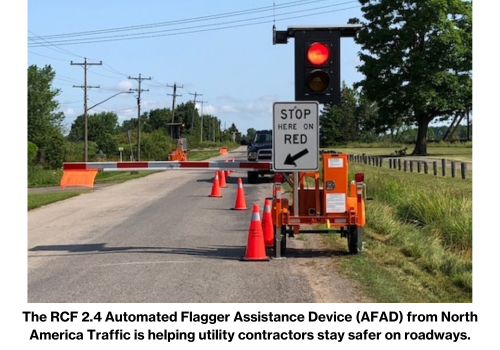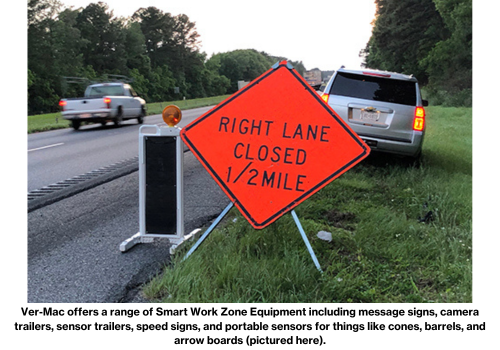Safety is critical in a higher-risk industry like utility construction. The constant challenge for construction companies is to deliver effective safety training and to stay up-to-date with the latest tools and technologies.
The Utility Expo provides a great opportunity to get a close-up look at the best safety technologies in the industry. Utility professionals can also attend several safety-related educational sessions. For instance, there’s a Field Classroom on safety technologies at The Utility Expo 2023. The show is also featuring its first-ever Safety Symposium in partnership with the American Traffic Safety Services Association (ATSSA). One of the many Safety Symposium sessions is covering the top roadway safety technologies.
We spoke with two safety experts who will be leading the above-mentioned educational sessions. The following are their thoughts on today’s must-have technologies to help make utility workers and jobsites safer.
1. Jobsite alert systems
Mobile alert systems are transforming the way emergencies are communicated and responded to on the jobsite.
“One of our industry’s requirements is that we can evacuate people in case of an emergency,” says Monica Rakoczy, Owner/Founder of EnterTRAINING Solutions. “Logistically trying to put everything together on paper is rather difficult, especially on sites that are continuously changing.”
A wireless mobile alert system is designed to function like a fire alarm in a building. But because it’s wireless and mobile, it can move around the jobsite. Some systems can also be activated from a mobile app. Whatever the case, the alert system can be integrated with mobile devices so certain individuals receive immediate notifications. You can also set up different types of notifications to go to different types of people, i.e. those who are trained in fire suppression or CPR.
“The notification will tell these people exactly where the emergency is,” Rakoczy explains. “This is better than the traditional system of several people having to make several phone calls.”
2. Traffic safety
Working on and adjacent to roadways presents its own set of risks for a utility contractor. Technology has been advancing safety in this area, too.
Automated Flagger Assistance Devices (AFADs) are a great example. An AFAD is a remotely controlled piece of traffic control equipment designed for operation by a single flagger, cutting labor in half. More importantly, the AFAD operator can be positioned far away from the roadway.
“It’s really important to properly coordinate the movement of traffic on a two-way roadway,” says Melodie Matout, Innovation and Technical Services Manager for the ATSSA. “An AFAD helps streamline this coordination while taking the single flagger out of hazard’s way.”
Depending on the AFAD being used, the flagger can remotely change the traditional stop/slow sign which is mounted to a trailer or other apparatus. Some AFADs also have traffic lights and gated arms to further alert motorists. “There are a lot of suppliers who offer this type of equipment now,” Matout points out.
Matout is also encouraged by the growing use of connected work zones, also known as smart work zones. By digitally connecting jobsite fixtures such as cones, barrels, arrow boards, trucks, and even people, motorists can be alerted to the accurate location and status of a work zone. Additionally, utility contractors can maintain an accurate view of what’s going on.
“A connected work zone provides real-time information, as opposed to information based on a schedule that might be outdated,” Matout says. “To explain it simply, you essentially place a kind of transponder on things like cones, arrow boards, and workers. Then you always know their location in real-time. That location data can be transmitted to state DOTs and others. At the same time, a utility contractor will know if a certain connected work zone device was knocked over or knocked offline. Then they can follow up and make sure everything is OK.”
3. Virtual reality training
Rakoczy says virtual reality training is becoming an increasingly popular technology, especially when it comes to heavy equipment.
“It’s becoming more relevant to spend time in a physical seat, even though this type of training is still video game-based,” Rakoczy says. “Many of these training programs give you the ability to specify which piece of equipment you’re operating, like a certain brand and model of excavator. Then you can practice through different scenarios using that specific machine’s controls.”
This type of training approach can be particularly effective with the younger generation that hasn’t been exposed to a construction-related career. “Marrying something they know, like playing video games, with virtual training can be a lot better than just turning them loose on the actual piece of equipment,” Rakoczy says. “Virtual reality training is a safer and more comfortable way for some people to learn the nuances of operating different types of machinery.”
4. Wearable devices
This safety technology involves attaching various types of mobile electronics and embedded sensors to the body and/or PPE. Different types of wearables can help detect proximity to machinery or other hazards, while others can help monitor things like ergonomics, fatigue, overexertion, stress levels, and more.
Rakoczy says certain types of wearables can also be very useful in certain applications, such as when individual workers are more isolated and need to be monitored remotely. Wearables that help detect certain dangerous gases can also be helpful for utility workers in the oil/gas and water/wastewater sectors. Some of these wearable metering devices connect to wireless signals for convenient, real-time data transmission to someone’s mobile device or computer.
 5. Integrated safety equipment
5. Integrated safety equipment
A lot of safety advances have been built right into the equipment contractors use every day. Collision avoidance systems are one example. These include blind-spot coverage, proximity detection alerts, detecting the presence of workers, and systems that monitor equipment operators and keep a record of their performance.
“It’s a lot more than just backup alarms now,” Rakoczy says. “Things have come a long way.”
On that note, Rakoczy says integrated safety tech includes devices that can be mounted to equipment like excavators and dump trucks. These devices can measure the power coming off of utility lines. “This advancement gives the average contractor access to a really useful technology,” Rakoczy says. “These devices are roaming and can go with the equipment, so a contractor doesn’t need one on every single piece of equipment. That gives them a great safety solution without having to spend so much money.”
6. Everyday essentials continue evolving
Technology is playing a huge role in making utility construction work safer these days. At the same time, Rakoczy says some of her favorite safety advancements are simple improvements to products that have been around forever.
“Sometimes you can spend so much time and thought on tech that you forget how the basics can be improved upon,” Rakoczy says. “There are a lot of items a utility contractor uses every day. Sometimes you take these things for granted and assume they will always remain the same. I’m really excited to see certain companies that are making some great improvements to what we could consider to be stock items.”
Take a hard hat, for instance, which has historically been somewhat clumsy and uncomfortable to wear. “Now you’re seeing these capped helmets and almost climbing-style helmets that still provide the same protection as an old-school construction helmet,” Rakoczy says. “These new helmets are more comfortable and durable.”
Rakoczy is also encouraged by improvements made to trench boxes.
“Putting a traditional trench box together can be a very dangerous process,” Rakoczy points out. “A company called GroundWorks has developed a system that basically puts itself together. You set it up on the ground and latch a couple of things together. Then the whole thing assembles itself when the excavator picks it up.”
Rakoczy is also impressed with the Miller DuraHoist Portable Confined Space System. She says it provides an effective alternative to the traditional tripod system used to rescue workers in a hole. It’s just another example of how manufacturers continue to innovate in the area of safety.
The Utility Expo is the largest event for utility professionals and construction contractors seeking comprehensive insights into the latest industry technologies, innovations and trends. Known for equipment test drives and interactive product demonstrations, you don’t want to miss this. Be there: September 26-28, 2023 in Louisville, Kentucky, U.S.A.
Discover new strategies and techniques while making lasting connections with your peers in the utility industry. Click here for more information on The Utility Expo's comprehensive education program.
Read Next
Top Tech Trends for Utilities in 2023












